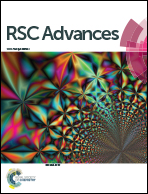Enhanced properties of fiberglass-reinforced photocurable resin pile by introducing different fiberglass surface treatments and their biological evolution†
Abstract
We aimed to investigate the influence of different fiberglass surface pretreatments on the interfacial and mechanical properties of fiberglass-reinforced photocurable (FRP) resin pile and evaluate their cytotoxicity. The fiberglass was treated by different types, such as heat and acid treatment, and then modified by KH570, which were immersed in a laboratory-prepared photocurable resin substrate to prepare FRP resin piles. Scanning electron microscope (SEM), thermogravimetric analyses (TGA) and Fourier transform infrared spectrum (FT-IR) were used to characterize the morphologies and structures. Furthermore, the flexural modulus, bending strength, and bending load of the FRP resin piles were analyzed and the cytotoxicity on L929 cells were measured via methyl thiazol tetrazolium (MTT) assay. The results showed that high treatment could enhance the combination of the fiberglass with KH570 and then mechanical properties of the FRP resin piles, but acid treatment could reduce the performance of the FRP resin piles. MTT assay revealed the low cytotoxicity, which could be a potential application.


 Please wait while we load your content...
Please wait while we load your content...